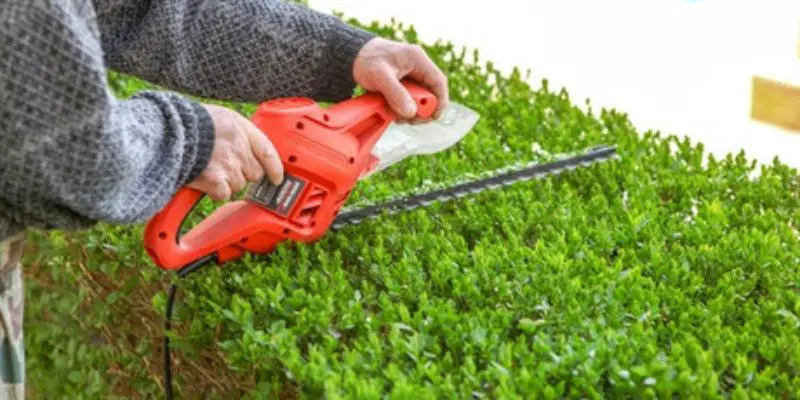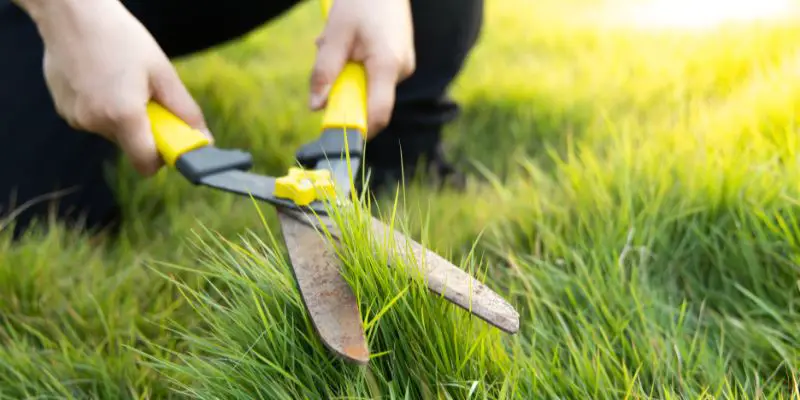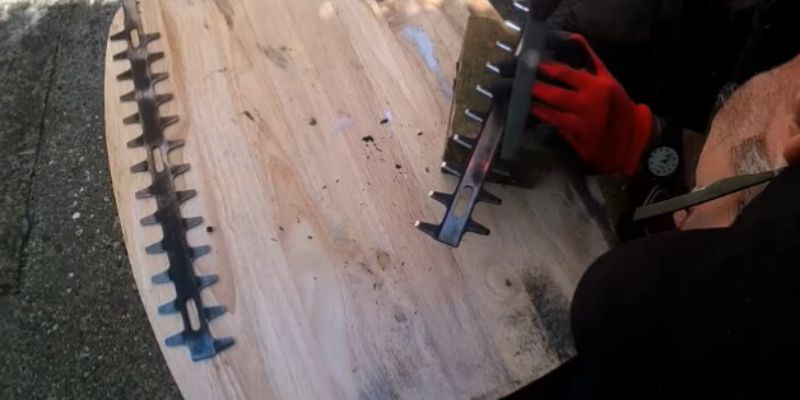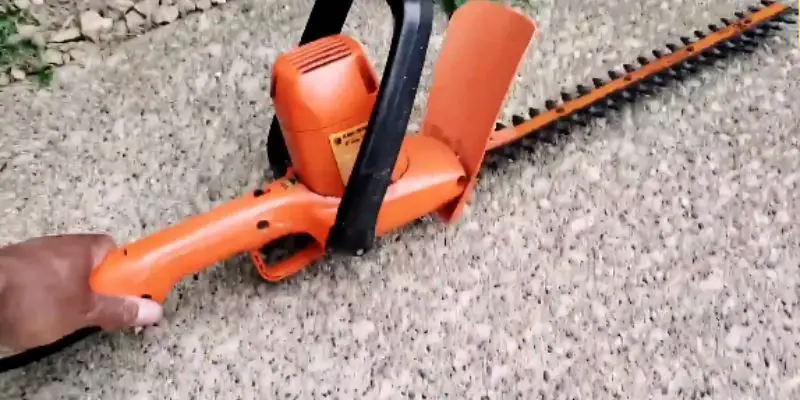Hedge shears are an essential gardening tool for pruning and trimming hedges, bushes, and shrubs. Learning how to properly use hedge shears will allow you to neatly shape and maintain your landscaping. This comprehensive guide will teach you everything you need to know about how to use hedge shears including choosing, caring for, and using hedge shears effectively.
Introduction to Hedge Shears
Hedge shears, also known as shrub shears or bush trimmers, are designed specifically for cutting branches and stems of woody plants. They have long, sharp blades that are 8-10 inches in length. The blades may be straight or curved. Hedge shears have short handles and are operated with one hand.
Unlike grass shears or pruners, hedge shears are intended for making continuous cuts along thick branches and stems up to around 3/4 inches in diameter. The long blades allow you to cut more material with each snip, speeding up shaping and trimming jobs.
Manual, electric, and gas-powered models are available. Manual shears are the most common for occasional home use. Electric or gas hedge shears offer more power and ease for frequent use or very thick/hardy shrubs.
Properly using hedge shears takes some practice. With the right techniques, you can create neat edges and uniform shapes for hedges and bushes in your yard.
Choosing the Best Hedge Shears
Several factors to consider when selecting hedge shears include:
- Blade length – 8-10 inches is optimal. Shorter blades are inefficient for large hedges. Longer blades are heavy and unwieldy.
- Blade type – Curved blades make clean cuts on stems at various angles. Straight blades work better for flat tops and sides.
- Blade coating – Non-stick Teflon or titanium coatings prevent sap and debris buildup.
- Handle design – Pistol grip or loop handles work for different hand sizes. Shock-absorbing handles reduce fatigue.
- Manual vs. electric – Electric shears provide power for frequent use. Manual models are fine for occasional trimming.
- Brand – Look for reputable brands like Fiskars, Gilmour, or Scotts for quality and durability.
- Price – Expect to pay $25-50 for manual shears, $50-100 for electric. Higher prices offer more cutting power and ruggedness.
Try out a few pairs to find the length, grip, and overall feel that suits you best. Invest in the highest quality hedge shears you can afford for their superior cutting ability and longevity.
Caring for Your Hedge Shears
With proper care and maintenance, quality hedge shears should provide many years of use. Here are some tips for keeping shears in top working condition:
- Clean blades after each use by wiping away sap, residue, and dirt with a cloth. Use soap and water if needed.
- Oil the blades regularly to prevent rust. Wipe off excess oil.
- Sharpen blades as needed to improve cutting performance. Use a whetstone or electric sharpener.
- Adjust blade tension if shears feel loose. Tighten just enough so blades meet without gap.
- Replace heavily worn or damaged blades. Most brands sell replacement blades.
- Store in a dry spot indoors or sheathed to protect from moisture. Avoid letting blades touch concrete.
- For electric shears, regularly clean air vents and replace worn electrical cords.
Well-maintained shears make hedge trimming less laborious. With sharp, lubricated blades, you can make quick, clean cuts through branches.
How to Use Hedge Shears
Using proper hedge shears technique will produce attractive, even shaping and healthy growth. Here are tips for effective use:
- Hold a pair of shears designed for right or left-handed use in your dominant hand. Maintain a firm but relaxed grip.
- Use your other hand to lightly hold the end of branches being cut, guiding the blades and preventing stripping of bark.
- Make overlapping cuts in one direction across stems about 1/4 inch from the previous cut. This ensures clean cuts without tearing.
- Position blades at a very slight outward angle so the bottom blade is tilted away from the hedge or shrub. This helps prevent jamming.
- Open blades fully and snip in smooth motions. Don’t saw back and forth. Let blades glide through stems with gentle pressure.
- Work top to bottom and outwards in for neat shaping. Cut tall inner growth first, then outer layer.
- Stand with knees slightly bent and feet shoulder-width apart for proper balance and leverage.
- Take small breaks to stretch your hands and wrist. Hedge shears require repetitive squeezing motions which can cause fatigue or strain.
With some practice adjusting your grip, stance, blade angle and snipping technique, you’ll be able to efficiently trim hedges to perfect uniformity using hedge shears. Maintaining your tools well also ensures an easier, frustration-free experience.
Trimming Different Types of Hedges
The techniques for using hedge shears remain basically the same for different hedge varieties. However, some types require a bit more knowledge to promote healthy growth after pruning.
Conifer Hedges
Popular conifers used in hedging like arborvitae, juniper, and yew should only be trimmed in spring before new growth emerges. Avoid shearing off the ends of branches; make thinning cuts back to a side shoot or main stem instead. This maintains the natural shape.
Boxwood Hedges
Boxwood benefits from frequent light trimming. Snip off up to one-third of new growth, cutting back to a leaf node. Time it before growth fully hardens. Thin inner branches occasionally to improve air circulation and light penetration.
Privet Hedges
These rapid growers can handle heavy shearing. Trim as needed through summer, but avoid cutting off more than 6 inches of new growth at once. This encourages dense regrowth. Always cut back to a healthy bud.
Beech Hedges
Trim beech hedges only in June or July when branches are semi-hardened. Cutting too early or late leads to disease. Maintenance trims should remove no more than 6 inches of growth.
Check your hedge type’s specific needs before getting the shears out. Proper timing and technique keeps them healthy and visually appealing.
7 Key Hedge Shears Trimming Tips
- Sharpen blades regularly for clean cuts that heal quickly.
- Cut outer foliage first, working inwards for uniform shaping.
- Trim top to bottom in layers for even sides.
- Angle blades slightly outward to avoid jamming.
- Don’t cut off more than 6 inches of new growth at once.
- Know optimal trimming times for your hedge species.
- Support stems near cuts to prevent bark stripping.
When to Trim Hedges
Hedge trimming schedules vary depending on the type, growth habits, and desired formal or informal shape. Here are some general guidelines on timing:
- Spring – Trim overwintered dieback and shape hedges just before new growth emerges. Avoid late spring cuts when sap is flowing.
- Early summer – Shape and trim spring growth once hardened off. Time it before a major growth spurt begins.
- Midsummer – Light trimming contained hedges. Don’t cut into unhardened new shoots.
- Late summer – Trim fast-growing hedges again before growth declines.
- Fall – Final trim if needed before winter but don’t cut into unhardened growth.
- Avoid winter – Trimming during dormancy can expose plants to disease and frost damage.
Monitor new growth and prune frequently enough to maintain desired shape without removing too much material at once. Proper timing prevents shock and keeps hedges growing vigorously.
Hedge Shears Safety Tips
Using hedge shears requires caution to avoid injuries:
- Wear protective leather gloves to shield hands from sharp blades and thorns.
- Use eye protection to block debris when trimming.
- Keep blades oiled and sharp to prevent jamming during cuts.
- Account for all persons (children, pets) in the trimming zone before starting.
- Avoid trimming in wet conditions for better traction and grip.
- Take breaks as needed to rest hands and prevent repetitive motion injuries.
- Store shears locked or with protective sheaths for safety when not in use.
- Maintain proper footing on ladders or lifts when trimming tall hedges.
- Electric shears should only be used with dry hands, away from water sources.
Stay alert, keep blades sharp, and trim cautiously. Make trimming a safe, pleasant task.
Troubleshooting Common Hedge Shears Issues
Problem solving basic hedge shears problems allows you to restore their optimal function:
Blades jamming/poor cut quality – Sharpen blades, lubricate, adjust tension
Hand/wrist pain – Improve grip, take breaks, stretch
Blades loose or misaligned – Tighten bolts, adjust alignment
Noisy operation – Lubricate pivot points, check for loose parts
Lack of cutting power – Replace dull blades, consider electric/gas model
Rust – Clean and oil blades, store in dry place
Debris buildup – Soak in soapy water, scrub with brush
Bent/damaged blades – Attempt adjustment, or replace blades/unit
Loose handles – Tighten/replace fasteners
Frayed electrical cords – Replace damaged cords immediately
Don’t force dull or damaged shears to struggle through branches. Regular sharpening and replacing worn parts preserves cutting performance. Seek repairs for issues you can’t remedy with basic maintenance. Taking good care of quality hedge shears will ensure they last for years of peak use.
FAQ On How to Use Hedge Shears
Hedge shears may seem like simple tools, but many common questions come up regarding choosing and using them effectively:
Q: Should I get gas-powered or electric hedge shears?
A: For occasional homeowner use, manual shears usually suffice. Choose electric for frequent, heavy-duty trimming of large hedges. Gas models are powerful but noisy.
Q: When should I replace my old hedge shears?
A: Replace once sharpening and adjustments no longer improve poor cutting ability. Also if blades are heavily damaged, warped, or rusted.
Q: What maintenance do hedge shears require?
A: Sharpen and lubricate blades before/after use. Check blade tension and tightness of bolts. Remove sap and debris buildup. Store indoors when not in use.
Q: Why do my shears jam sometimes during cuts?
A: Blades likely need sharpening. Add lubricant. Don’t close blades all the way during cuts. Adjust blade tension. Angle blades outward slightly.
Q: How can I tell if my hedge shears are dull?
A: Jagged cut edges, difficulty making clean cuts, and the blades appear blunt upon visual inspection indicate dulling. Hone or professionally sharpen them.
Q: Do I need special safety gear to use hedge shears?
A: At minimum, wear leather gloves and eye protection. Use ear protection with gas/electric shears. Maintain sure footing if trimming from a ladder.
Q: How short can I cut back new hedge growth when trimming?
A: Limit removal to 6 inches or 1/3 of new growth to avoid shock and dieback. Leave some green foliage intact.
Q: What causes blisters on my hands after using hedge shears?
A: Blisters result from prolonged gripping and friction. Improve grip technique. Wear gloves. Take occasional breaks to rest hands.
Proper use and care makes hedge shears perform at their best for picture-perfect hedges. Don’t hesitate to replace aging or faulty tools.
Conclusion
Hedge shears are designed expressly for shaping and pruning hedges, bushes and shrubs. With the right pair for your needs, proper care, and technique, you can create tidy, crisp edges along your landscape beds.
Key points to remember are choosing quality shears suited to your hand size and task, keeping blades sharp and lubricated, knowing optimal timing for trimming different species, and practicing safe, efficient cutting motions.
Investing in this indispensable gardening tool and learning how to use hedge shears correctly allows you to maintain stunning formal and informal hedges that enhance your exterior space all year long.
Also read:
Best Electric Bush Trimmers – Top 5 Reviews and Buying Guide

Michael Glenn is a certified arborist and horticultural expert with over 15 years of experience in the landscape industry. His passion for plants and trees has led him to become a sought-after authority on pruning and trimming techniques. Glenn’s in-depth knowledge of proper pruning methods, timing, and tools has helped countless homeowners and professionals maintain healthy, aesthetically pleasing gardens and landscapes.
In addition to sharing his pruning expertise through practical tips, step-by-step guides, and expert advice, Glenn is also a respected author of pruning tool buying guides. His comprehensive reviews and comparisons ensure readers can make informed decisions when investing in quality loppers, pruning shears, saws, and other essential equipment. With a deep understanding of plant biology and sustainable practices, Glenn’s writing empowers audiences with the knowledge needed to properly care for green spaces.





